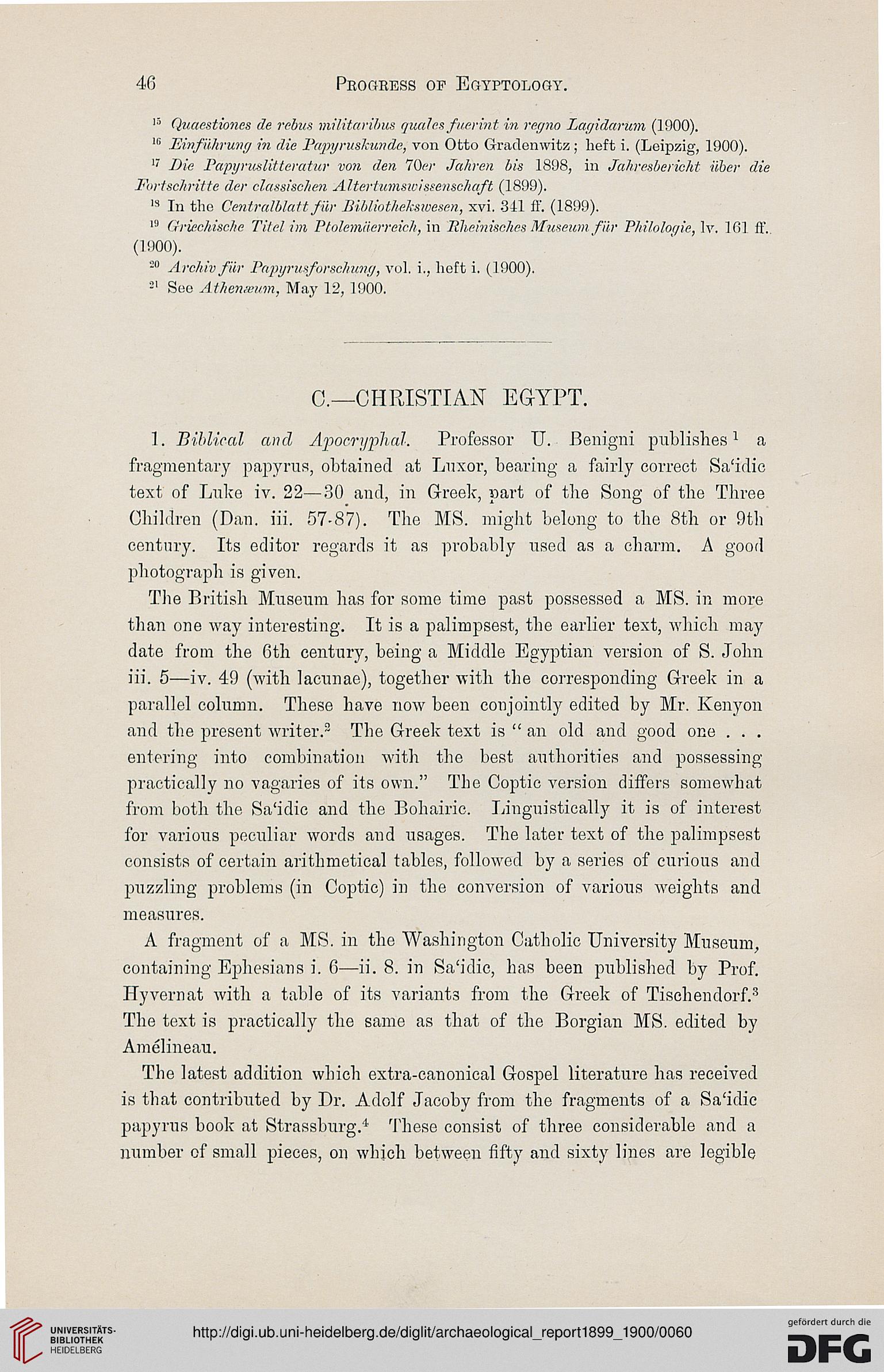46
Progress of Egyptology.
15 Quacstioncs de rebus militaribus quales fuerint in regno LagidarUm (1900).
16 Eivfuhrung in die Papyruskunde, von Otto Gradenwitz ; heft i. (Leipzig, 1900).
17 Die Papyruslitteratur von den 70er Jahren bis 1898, in Jahresbericht iiber die
Fortschritie der classischen Altertumswissenschaft (1899).
,s In the Centralblatt fur Bibliothekswesen, xvi. 341 ff. (1899).
13 Chnechische Tile! im Piolemaerreich, in Rheinisclies Museum fir Philolor/ie, Iv. 10] ft'.
(1900).
20 Arc/tivfir Papyrusforschung, vol. i., heft i. (1900).
-1 See Athenseum, May 12, 1900.
0.—CHRISTIAN EGYPT.
1. Biblical and Apocryphal. Professor U. Benigni publishes1 a
fragmentary papyrus, obtained at Luxor, bearing a fairly correct Sa'idie
text of Luke iv. 22—30 and, in Greek, part of the Song of the Three
Children (Dan. iii. 57-8*7). The MS. might belong to the 8th or 9th
century. Its editor regards it as probably used as a charm. A good
photograph is given.
The British Museum has for some time past possessed a MS. in more
than one way interesting. It is a palimpsest, the earlier text, which may
date from the 6th century, being a Middle Egyptian version of S. John
iii. 5—iv. 49 (with lacunae), together with the corresponding Greek in a
parallel column. These have now been conjointly edited by Mr. Kenyon
and the present writer.2 The Greek text is " an old and good one . . .
entering into combination with the best authorities and possessing
practically no vagaries of its own." The Coptic version differs somewhat
from both the Sa'idie and the Bohairic. Linguistically it is of interest
for various peculiar words and usages. The later text of the palimpsest
consists of certain arithmetical tables, followed by a series of curious and
puzzling problems (in Coptic) in the conversion of various weights and
measures.
A fragment of a MS. in the Washington Catholic University Museum,
containing Ephesians i. 6—ii. 8. in Sa'idie, has been published by Prof.
Hyvernat with a table of its variants from the Greek of Tischendorf.3
The text is practically the same as that of the Borgian MS. edited by
Amelineau.
The latest addition which extra-canonical Gospel literature has received
is that contributed by Dr. Adolf Jacoby from the fragments of a Sa'idie
papyrus book at Strassburg.4 These consist of three considerable and a
number of small pieces, on which between fifty and sixty lines are legible
Progress of Egyptology.
15 Quacstioncs de rebus militaribus quales fuerint in regno LagidarUm (1900).
16 Eivfuhrung in die Papyruskunde, von Otto Gradenwitz ; heft i. (Leipzig, 1900).
17 Die Papyruslitteratur von den 70er Jahren bis 1898, in Jahresbericht iiber die
Fortschritie der classischen Altertumswissenschaft (1899).
,s In the Centralblatt fur Bibliothekswesen, xvi. 341 ff. (1899).
13 Chnechische Tile! im Piolemaerreich, in Rheinisclies Museum fir Philolor/ie, Iv. 10] ft'.
(1900).
20 Arc/tivfir Papyrusforschung, vol. i., heft i. (1900).
-1 See Athenseum, May 12, 1900.
0.—CHRISTIAN EGYPT.
1. Biblical and Apocryphal. Professor U. Benigni publishes1 a
fragmentary papyrus, obtained at Luxor, bearing a fairly correct Sa'idie
text of Luke iv. 22—30 and, in Greek, part of the Song of the Three
Children (Dan. iii. 57-8*7). The MS. might belong to the 8th or 9th
century. Its editor regards it as probably used as a charm. A good
photograph is given.
The British Museum has for some time past possessed a MS. in more
than one way interesting. It is a palimpsest, the earlier text, which may
date from the 6th century, being a Middle Egyptian version of S. John
iii. 5—iv. 49 (with lacunae), together with the corresponding Greek in a
parallel column. These have now been conjointly edited by Mr. Kenyon
and the present writer.2 The Greek text is " an old and good one . . .
entering into combination with the best authorities and possessing
practically no vagaries of its own." The Coptic version differs somewhat
from both the Sa'idie and the Bohairic. Linguistically it is of interest
for various peculiar words and usages. The later text of the palimpsest
consists of certain arithmetical tables, followed by a series of curious and
puzzling problems (in Coptic) in the conversion of various weights and
measures.
A fragment of a MS. in the Washington Catholic University Museum,
containing Ephesians i. 6—ii. 8. in Sa'idie, has been published by Prof.
Hyvernat with a table of its variants from the Greek of Tischendorf.3
The text is practically the same as that of the Borgian MS. edited by
Amelineau.
The latest addition which extra-canonical Gospel literature has received
is that contributed by Dr. Adolf Jacoby from the fragments of a Sa'idie
papyrus book at Strassburg.4 These consist of three considerable and a
number of small pieces, on which between fifty and sixty lines are legible





